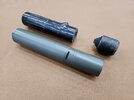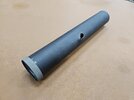berettaprofessor
Member
I had a little fright/puzzlement last Sunday. Went to plink with a Ruger 10/22 that is mostly stock; it's mounted with a Leupold 3-9X40 VX1 on Talley 10/22 mounts. It also has a Tacticool threaded adaptor on the front sight. It normally shoots about 1.5 MOA at 50 yards with CCI Standard. It was sighted in last year so I threw on a Tactical Solutions suppressor and fired away and it was nowhere near on paper at 50 yards...a foot low and left at least. I'm pretty sure previously it was fine with this suppressor; no POI shift appreciated. I adjusted and adjusted and found that I didn't have enough movement in the scope to get it any closer than 6 inches low and left. Perplexed and out of time, I put it up for the weekend.
Today I didn't use the silencer and was back on target in 8 or 10 rounds. So I did a little experiment...removed the thread protector....and it's still on target. Got the suppressor and put it back on....way off low and left again. Removed the suppressor without adjusting the scope and it was back on target. So it's not the rifle, at least.
I've had this suppressor for years. It never affects POI on 22lr pistols or a Charger that I notice. On some 10/22's with threaded barrels or a S&W MP 15-22 with a similar Tacticool adaptor, it raises POI about an inch but doesn't affect windage at all. So what gives?
I'm going to go back this weekend and put it on other rifles again....Just to see if something has changed with the suppressor.
Today I didn't use the silencer and was back on target in 8 or 10 rounds. So I did a little experiment...removed the thread protector....and it's still on target. Got the suppressor and put it back on....way off low and left again. Removed the suppressor without adjusting the scope and it was back on target. So it's not the rifle, at least.
I've had this suppressor for years. It never affects POI on 22lr pistols or a Charger that I notice. On some 10/22's with threaded barrels or a S&W MP 15-22 with a similar Tacticool adaptor, it raises POI about an inch but doesn't affect windage at all. So what gives?
I'm going to go back this weekend and put it on other rifles again....Just to see if something has changed with the suppressor.



